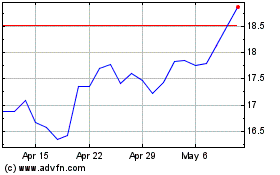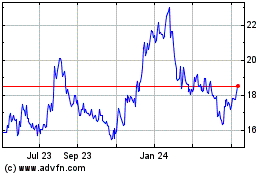Treasury Says Financial Rescues Will Turn Profit
March 30 2011 - 5:29PM
Dow Jones News
The U.S. government's emergency programs that helped steady the
financial system starting in 2008 are expected to turn an overall
profit of nearly $24 billion, the Treasury Department said in a new
analysis Wednesday.
Treasury officials also said they have now generated a profit
from the Troubled Asset Relief Program's loans to banks after three
financial institutions repaid a total of $7.4 billion in TARP funds
Wednesday.
The banks were SunTrust Banks Inc. (STI), of Atlanta; KeyCorp
(KEY), of Cleveland; and Financial Institutions Inc. (FISI), of
Warsaw, N.Y.
Treasury said TARP bank programs are now "in the black" by $6
billion. The federal government initially spent $245 billion to
assist troubled banks in the U.S., and now has $251 billion in
total repayments, dividends, interest and other income.
"While our overriding objective with TARP was to break the back
of the financial crisis and save American jobs, the fact that our
investment in banks has also delivered a significant profit for
taxpayers is a welcome development," Treasury Secretary Tim
Geithner said.
Treasury expects to eventually turn a $20 billion profit on the
nation's troubled banks from the TARP program alone.
Still, the Congressional Budget Office Tuesday trimmed its
estimate on the cost of the overall Troubled Asset Relief Program
to $19 billion. That's well down from an initial estimate of $356
billion, but continues to reflect losses on the bailout of American
International Group Inc. (AIG), aid to the automotive industry, and
grant programs aimed at avoiding foreclosures.
And results remain uneven across the banking sector. Larger
institutions are repaying government funds, but scores of smaller
banks have missed various payments.
Meanwhile, Treasury's overall $23.6 billion profit estimate for
all emergency lending programs was announced in a blog post by
Timothy Massad, acting assistant secretary for financial stability.
It does not include the roughly $800 billion in stimulus funds
authorized in 2009.
The largest profits stemmed from the Federal Reserve's emergency
lending programs, which generated $110.0 billion, Treasury said.
Those offset a projected $73 billion loss in money spent to
stabilize mortgage giants Fannie Mae (FNMA) and Freddie Mac (FMCC).
Rescuing the two companies has cost taxpayers $134 billion to date,
but that spending is expected to be offset by dividend payments
over the next decade.
The new Treasury analysis came on the same day Massad sparred
with a departing federal bailout watchdog over the legacy of TARP
at a congressional hearing.
On his final day on the job, Neil Barofsky, the special
inspector general for TARP, warned that the same "too big to fail"
firms that nearly brought down the financial system in 2008 have
become bigger and more interconnected and continue to maintain an
unfair advantage over small competitors.
"TARP's most significant legacy may be the exacerbation of the
problems posed by 'too big to fail,' particularly given the manner
in which Treasury executed the bailout," Barofsky said. He noted
that the bailout largely spared "executives, shareholders,
creditors and counterparties, reinforcing that not only would the
government bail out the largest institutions, but would do so in a
manner that would do little harm to the responsible
stakeholders."
But Massad, who testified later at the same hearing, rejected
the idea that TARP's main legacy was to perpetuate the "too big to
fail" problem.
"TARP was necessary to respond to the worst financial crisis we
faced in decades," he said in his remarks. "Its most significant
legacy is that it, combined with a variety of other government
actions, helped save our economy from a catastrophic collapse and
may have helped prevent a second Great Depression."
-By Andrew Ackerman and Jeffrey Sparshott; Dow Jones Newswires;
202-569-8390; andrew.ackerman@dowjones.com
--Alan Zibel contributed to this report.
Financial Institutions (NASDAQ:FISI)
Historical Stock Chart
From Aug 2024 to Sep 2024

Financial Institutions (NASDAQ:FISI)
Historical Stock Chart
From Sep 2023 to Sep 2024
